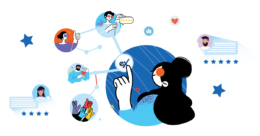Originally published on Customer Think
The customer has always been right, but the ways in which the customer is right seem to be changing all the time. The scramble for companies to refine and maximize their customer experience only got more intense during 2020, and that intensity is poised to continue well into this year and beyond.
COVID-19 changed the business-customer relationship for good, but CX has been slow to respond to this fact. 2021 will undoubtedly see scores of businesses playing catch-up, searching for ways to reach customers remotely and continue to operate in a fractured world. If you’re wondering what that might look like in terms of tangible trends, here’s what to watch out for:
1. Platform Centralization
Managing CX has become an increasingly complex thing to do, combining areas of design, customer relations, marketing, and much more. Businesses that try to run a patchwork CX enterprise by keeping all of these areas separate do so at their own peril. 2020 made many companies realize just how crucial it is to centralize as many CX elements as possible onto a single platform.
Scott Harris, CEO of experience management software company Experience.com, looks into the crystal ball on this issue: “As enterprises become more sophisticated, they will demand a single, integrated customer experience platform that combines data, behavior, and marketing from one platform. And those enterprises should not have to pay millions of dollars for a consultant to build a customized program.” In the past, the right platforms to do this may have been prohibitively expensive — 2021 will see prices get to a point where most companies have no choice but to buy in.
2. Opportunities for Connection
The pandemic seriously limited the avenues that companies had for connecting with customers. Traditional routes like email or mailers were still on the table but simply could not compare with getting to meet your patrons in person. Opportunities for connection needed to be embedded directly into the customer experience itself.
Thankfully, these opportunities are starting to arise, namely in the form of direct messaging between business and customer. Aditya Tendulkar, product manager for Google, explains that “As more people try to make more informed decisions before leaving the house, we’ve seen an uptick in the number of messages sent to businesses. Since the beginning of this year, people have initiated more than twice as many messages to merchants right from Business Profiles on Search and Maps.” Companies need to prepare for more interactions like these in the coming year and make sure they have a consistent online presence if they want to be able to connect with their clientele wherever they may be.
3. Active CX
CX is normally focused on guiding customers through and around your business, while getting customers in the first place is generally left to sales and marketing — this model will no longer do. CX now needs to actively work to attract and retain customers in ways that it simply didn’t before. With sales and marketing teams stretched thin, it’s CX’s turn to step up to the plate.
What this means in practice is that CX needs to become active. Customer surveys need to double as reminders of exactly what makes your business so great in the first place. The future of CX is the ability to collect customer experience data in the moment so you can take action while experiences are still happening, instead of random, long-form surveys. Your CX system should allow and encourage you to regularly connect with previous customers and re-engage them. The more work you can do on this front with CX, the light the load will be on your other teams this year.
4. Optimized Self-Service
While the importance of human connection can never be overstated, there is something to be said for letting customers handle things the way they want to. According to Kate Crane, content marketing manager for Zendesk, 67% of customers actually prefer self-service to dealing with an employee. She explains: “At the heart of a sterling self-service offering? A killer FAQ page. Customers who’d rather help themselves will greet a well-designed FAQ page as a useful tool — and a welcome relief.”
Whether it’s an FAQ page, a landing page, or a chatbot to help customers navigate your site — it makes no difference. The takeaway here is that your CX needs to include sufficient infrastructure for those who want to go it alone. For 2021, efficiency will be key for those hoping to stay afloat, and there’s no better way to maximize efficiency than by letting your customers do all the work themselves.
5. Personalization
Even if they’d rather do things on their own, customers still want to know that you care. Even just some mild CX personalization efforts can go a long way towards establishing a lasting relationship between your business and your customers. While this would be a boon in any year, it’s especially crucial in 2021: as the pandemic nears its final stages, consumers are ready to spend big again, but that money isn’t just going to go anywhere. People are going to patronize the businesses that connected with them best during the pandemic; the right CX personalization moves on your part can make sure that your business is part of that group.
6. Automation
Even a fully refined customer experience still needs agents to support it, and those agents are stretched thinner than ever. With the need for high-performing CX agents not going away anytime soon, it’s up to automation to step in and lighten the load.
Hervé Leroux, marketing and communication director at cloud communication platform Odigo, sees the shift towards automation as necessary: “By helping agents focus on the most essential tasks and reducing the potential for error, automation enables them to perform at their best. Customers in turn benefit from agents’ enhanced focus on high-value interactions.” Without automation, your CX team will be swamped in 2021. With automation, the chance at smooth sailing is greater than ever before.
The world of CX is constantly evolving, but 2021 will see it move faster than ever before. If companies want to roll with the changes, they’ll need to be quick to adapt to the newest trends and technologies — start with this list, and move on from there.











